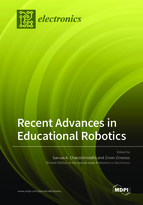Recent Advances in Educational Robotics
A special issue of Electronics (ISSN 2079-9292). This special issue belongs to the section "Artificial Intelligence".
Deadline for manuscript submissions: closed (15 July 2022) | Viewed by 46469
Special Issue Editors
Interests: artificial intelligence; computer vision; educational robotics; image retrieval
Special Issues, Collections and Topics in MDPI journals
Special Issue Information
Dear Colleagues,
Robotics has drawn great interest from teachers and researchers over the last decade as a powerful tool to improve cognitive and social skills for preschool to high school students and to facilitate learning in science, mathematics, technology, computer science, and other school subjects or interdisciplinary learning activities. More specifically, educational robotics aims to improve the learning experience of people through the creation, implementation, improvement, and validation of pedagogical activities, tools (e.g., guidelines and templates), and technologies, where robots play an active role and pedagogical methods inform each decision. Educational robotics has emerged as a unique learning tool that can offer hands-on, fun activities in an attractive learning environment promoting students’ interest and curiosity.
A review of the literature reveals that educational robotics is a growing field with the potential to significantly impact the nature of science and technology education at all levels, from kindergarten to university.
Topics of interest for this Special Issue include but are not limited to the following:
- Educational robotics platforms;
- Educational robotics competitions;
- Educational robotics technological products and practices;
- Educational robotics learning processes;
- Educational robotics pilots and best practices;
- Computational thinking through educational robotics.
Dr. Savvas A. Chatzichristofis
Dr. Zinon Zinonos
Guest Editors
Manuscript Submission Information
Manuscripts should be submitted online at www.mdpi.com by registering and logging in to this website. Once you are registered, click here to go to the submission form. Manuscripts can be submitted until the deadline. All submissions that pass pre-check are peer-reviewed. Accepted papers will be published continuously in the journal (as soon as accepted) and will be listed together on the special issue website. Research articles, review articles as well as short communications are invited. For planned papers, a title and short abstract (about 100 words) can be sent to the Editorial Office for announcement on this website.
Submitted manuscripts should not have been published previously, nor be under consideration for publication elsewhere (except conference proceedings papers). All manuscripts are thoroughly refereed through a single-blind peer-review process. A guide for authors and other relevant information for submission of manuscripts is available on the Instructions for Authors page. Electronics is an international peer-reviewed open access semimonthly journal published by MDPI.
Please visit the Instructions for Authors page before submitting a manuscript. The Article Processing Charge (APC) for publication in this open access journal is 2400 CHF (Swiss Francs). Submitted papers should be well formatted and use good English. Authors may use MDPI's English editing service prior to publication or during author revisions.
Keywords
- Educational robotics
- Low-cost electronics for educational robotics
- STEM
- Educational platforms
- Robotics competitions
- Learning processes
- Pilots and best practices
- Computational thinking through educational robotics







